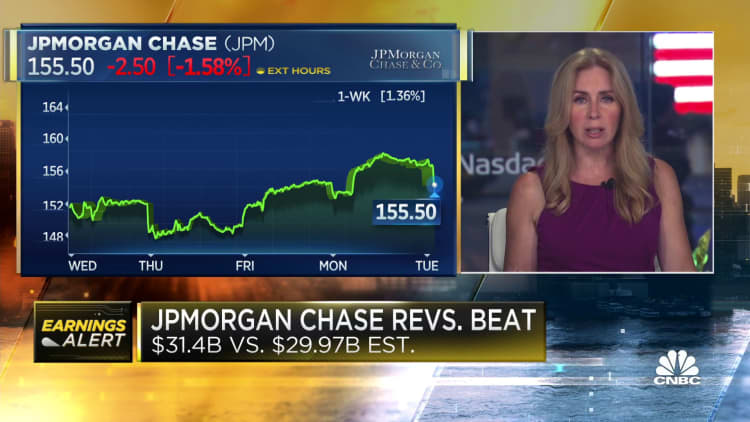
JPMorgan Chase on Tuesday reported second-quarter profit and revenue that exceeded analysts' expectations as the banking giant released money set aside for loan losses.
Here are the numbers:
Earnings: $3.78 per share versus the $3.21 per share estimate in a Refinitiv survey of analysts.
Revenue: $31.4 billion versus the $29.9 billion estimate.
One key factor is that after the industry set aside tens of billions of dollars for loan losses last year, banks have been releasing reserves as borrowers have held up better than expected.
That happened in the second quarter at JPMorgan, the biggest U.S. bank by assets. The firm posted a $2.3 billion boost from releasing $3 billion in loan loss reserves after taking $734 million in charge-offs. The bank had a $5.2 billion reserve release in the first quarter.
"Consumer and wholesale balance sheets remain exceptionally strong as the economic outlook continues to improve," CEO Jamie Dimon said in the release. "In particular, net charge-offs, down 53%, were better than expected, reflecting the increasingly healthy condition of our customers and clients."
The bank said the improving U.S. economic outlook drove its decision to release money set aside for loan losses, which came mostly from retail credit-card and mortgage reserves.
Trading revenue fell 30% from the year earlier period, an expected outcome after the frenzied activity in the aftermath of Federal Reserve actions to bolster markets during the early stage of the coronavirus pandemic.
Fixed income trading produced $4.1 billion in revenue, just under the $4.16 billion estimate of analysts surveyed by FactSet. Equities trading generated $2.69 billion in revenue, topping the $2.31 billion estimate. The combined figure was in line with Dimon's guidance last month of "a little north of $6 billion" in trading revenues.
Investment banking helped offset the drop in revenue from trading. The firm posted $3.4 billion in investment banking revenue, exceeding the estimate by $300 million, on strength in mergers activity and acquisition financing.
During an earnings conference call, analysts may ask Dimon about the bank's succession planning after it named two senior executives, Marianne Lake and Jennifer Piepszak, to run the company's sprawling consumer bank. The changes led to the promotion of global research head Jeremy Barnum to CFO succeeding Piepszak; this is Barnum's first quarter handling the firm's earnings release.
Dimon may also be asked about his acquisition strategy after making the third purchase of a fintech start-up since December. Last month, the bank agreed to buy ESG investing platform OpenInvest, CNBC reported first.
JPMorgan dipped 2.6% after the earnings report on Tuesday. Shares of the bank have climbed 24% this year before Tuesday, exceeding the 17% rise of the S&P 500.
Wall Street rival Goldman Sachs posted results on Tuesday that handily beat expectations, helped by strong revenue from Wall Street advisory activities.
Become a smarter investor with CNBC Pro.
Get stock picks, analyst calls, exclusive interviews and access to CNBC TV.
Sign up to start a free trial today.


